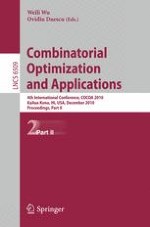The 4th Annual International Conference on Combinatorial Optimization and Applications (COCOA 2010) took place in Big Island, Hawaii, USA, December 18–20, 2010. Past COCOA conferences were held in Xi’an, China (2007), Newfoundland, Canada (2008)and Huangshan, China (2009). COCOA2010providedaforumforresearchersworkingintheareasofcom- natorial optimization and its applications. In addition to theoretical results, the conference also included recent works on experimental and applied research of general algorithmic interest. The Program Committee received 108 submissions from more than 23 countries and regions, including Australia, Austria, Canada, China, Denmark, France, Germany, Hong Kong, India, Italy, Japan, Korea, Mexico, New Zealand, Poland, Slovak Republic, Spain, Sweden, Switzerland, Taiwan, UK, USA, Vietnam, etc. Among the 108 submissions, 49 regular papers were selected for presentation at the conference and are included in this volume. Some of these papers will be selected for publication in a special issue of the Journal of Combinatorial Optimization, a special issue of Theoretical Computer Science, a special issue of Optimization Letters, and a special issue of Discrete Mathematics, Algorithms and Applications under the standard refereeing procedure.
